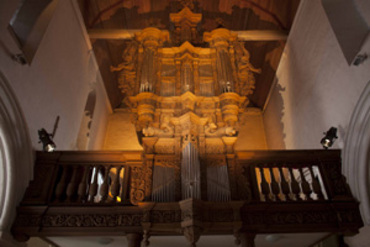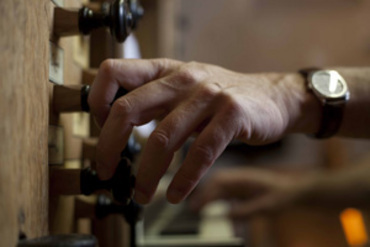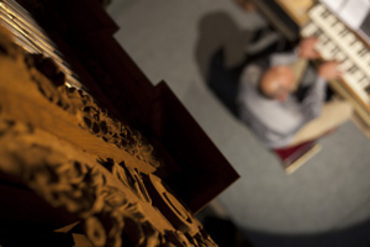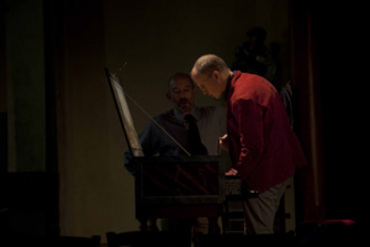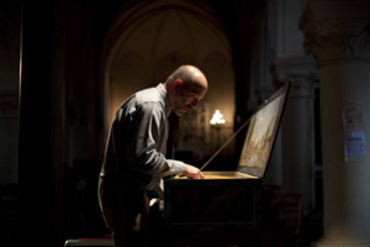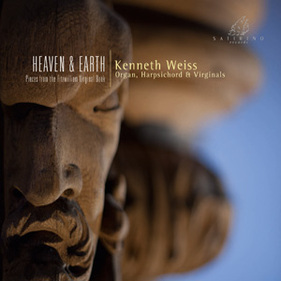Satirino records · Heaven & Earth
Pieces from the Fitzwilliam Virginal Book
Kenneth Weiss Organ, Harpsichord & Virginals
Satirino records SR132 - released 30th September 2013
John Bull, William Byrd, Giles Farnaby, Thomas Morley, Ferdinando Richardson, Thomas Tallis, William Tisdall, Francis Tregian
Recording
St Pierre's Church, Nielles-lès-Ardres, Pas-de-Calais, France, 29 & 30 ix 2012
Instruments
Organ of the church of St Pierre, Nielles-lès-Ardres, 1696
Harpsichord after Lodewijk Theewes, London, 1579, by Malcolm Rose
Mother & Child after Ioannes Ruckers, 1623, by Andreas & Jacob Kilström
Sound engineer, producer, editing, mastering
Jiri Heger
Images
© Arthur Forjonel
Tuning
François Ryelandt
A 415 Hz, 1/4 syntonic comma meantone
Design
le monde est petit
Liner notes by Richard Langham Smith
Thanks to
Dominique Dupillet, Sébastien Mahieuxe, Patricia et François Meurisse, Malcolm Rose, Andreas Kilström, François Ryelandt, Supercloclo, Aline Pôté & Arthur Forjonel


Press reviews
“Tirées du volumineux recueil anglais « The Fitzwilliam Virginal Book », immense compilation de près de 300 pièces pour le clavier, et mise en forme à la fin du XVI° siècle et au début du XVII° siècle, Kenneth Weiss nous offre un choix judicieux de pièces sur divers instruments adaptés à ce répertoire. Il faut dire aussi que la qualité des œuvres de cet important ouvrage est de tout premier plan, avec des compositions écrites pour la plupart par les plus grands compositeurs de l’époque : Tallis, Bull, Byrd, Farnaby, et autres Sweelinck, tous grands virtuoses du clavier en Angleterre et dans les Flandres. L’approche de Kenneth Weiss est très séduisante, utilisant tout d’abord l’orgue renaissance de Nielles-lès-Ardres, dans le Pas-de-Calais, proche de l’Angleterre. Cet instrument, de facture flamande, remonte à la toute fin du XVI° siècle. Tempérament mésotonique et diapason ancien apportent un relief indispensable à ces textes musicaux, notamment un jeu de tierce pouvant s’intégrer dans les ensembles de plein-jeu. Ensuite, le choix du virginal est incontournable, puisqu’il fut l’instrument à clavier le plus répandu et utilisé, apprécié par un son doux et luthé, par le fait des cordes pincées en leur milieu. Le clavecin lui, plus franc d’attaque, par sa corde pincée près du chevalet, apporte un contraste efficace dans cette anthologie. Le présent disque propose un programme pertinent, donnant à la fois une idée juste de cette œuvre, par un bouquet de pièces très varié, et soutenu par le jeu expert et raffiné de Kenneth Weiss. On se laissera envoûter par les variations sur ‘Walsingham’ de William Byrd, lamentation rappelant la destruction de l’abbaye du même nom perpétrée par Henri VIII au XVI° siècle, variations reprises aussi dans le même recueil par son compatriote John Bull. C’est une approche idéale pour découvrir et entrer dans ce monde étrange, virtuose et ténébreux, du clavier anglais à l’époque d’Elisabeth I.” ResMusica, Frédéric Muñoz
“Poursuivant l’exploration du Fitzwilliam Virginal Book, Kenneth Weiss enregistre une grande diversité des morceaux : certains sont ambitieux - variations ou petit recueil de Richardson ou Tallis - d’autres miniatures (toys), écrits pour débutant et pleins de charme. Outre le somptueux orgue du XVIIe siècle de Nielles-lès-Ardres, on découvre un couple de virginals ‘mère et enfant’ destinés à ces petits bijoux de musique dont le claveciniste met en lumière la vivacité de l’esprit. Les pièces de l’inventif John Bull sont un régal et les subtilités harmoniques bien différentes de Morley et Byrd réjouissent l’oreille.” Michèle Fizaine, Midi Libre
Liner note
This recording consists entirely of pieces from the so-called Fitzwilliam Virginal Book: an entirely inappropriate title from two points of view! It was neither named after its compiler—perhaps Francis Tregian—nor was it really a virginal book. Indeed, one of the strengths of this recording is that in assigning the more extended pieces to the harpsichord and organ, it unveils the extraordinary breadth of the collection: from imposing organ preludes and plainsong pieces; monumental harpsichord variations and pairs of Pavans and Galliards; to delightful little ‘toys’, not too difficult for debutants to play and utterly full of charm. So although the title subsequently given to the collection suggests Virginals as the desired instrument, it is clear that fairly robust harpsichords and, here and there, an organ were intended. The idea that these pieces were intended for the delicate white hands of Elizabethan virgins—perhaps contrasting with the ebony naturals of the keyboard—is simply not borne out.
Added to the organ and harpsichord in this recording is a unique set of virginals: a ‘mother and child’. Virginals were made in various sizes and sounded at various pitches but the most curious of them all—and the most delightful—was a type of virginal which contained, in a drawer, a pull-out virginal sounding an octave higher than the main keyboard. It could be coupled to the ‘parent’ keyboard, thus sound the two octaves at once (like the 8’ and 4’ on a harpichord or organ) or it could be played on its own, like an Italian instrument known as the ottavino. ‘A Toye’ (Track 12) and ‘Almand’ (Track 14) on the present recording are played on the ‘child’, while the other tracks give us the chance to hear the ‘parent’, except for ‘Can shee’, ‘Corrãto’ and the little ‘Gigge’ (Tracks 9, 10 & 11) where the unique sound of the ‘Mother and Child’ together can be heard.
In the end the collection was named after its first purchaser: the eighteenth- and nineteenth-century collector Viscount Fitzwilliam who bequeathed it to the University of Cambridge in 1816. The very substantial manuscript has been convincingly dated at before 1618 by one scholar. Once fancifully considered to be Queen Elizabeth’s own collection of virginal music, that myth has now been affirmatively dispelled. Other tantalising unanswered questions remain, and scholars have disputed with each other over its purpose, its compiler and its copyist.
The first to present it to the world were the nineteenth-century music scholars Fuller Maitland and Barclay Squire, followed by a commentary by E. W. Naylor, reminding us of the strength of the late nineteenth-century’s interest in unearthing England’s history in the finest of detail—by no means in music alone. Fuller Maitland was a writer on music with a particular interest in revival and preservation: of Bach and of English regional folksong, among other things. His collaboration with his brother-in-law Barclay Squire on the Fitzwilliam Virginal Book was an enormous labour of love which came to fruition between 1894 and 1899 and has not been superseded, although their conjectures have given rise to much scholarly debate not helped by the two Francis Tregians, father and son, who carried the same Christian name.
The family adopted a Cornish surname, but the father maintained links with a Catholic stronghold in Douai. They were intransigent Catholics, particularly the father, and both, according to one source, were at some time imprisoned for recusancy in the Fleet prison: (the word ‘recusant’ being synonymous with the period when being a Catholic was synonymous with being a traitor).
Tregian the younger was without doubt involved in the compilation of the collection: known by some as ‘Tregian’s anthology’ it clearly has signatures and handwriting in Tregian the younger’s hand. Less easy to prove is that the music-copyist’s hand is his. But many have asserted—after Fuller Maitland and Barclay Squire—that Tregian spent his time in prison copying out the vast array of pieces: another nice story. Others have refuted this: how could he have collected such a vast amount of music when he was banged up in prison? Yet others have suggested that he could, because it was quite common to buy time out.
Then there is the Catholic theory: that most of the composers in the collection were Catholics and that it was the family’s staunch Catholicism for which the Tregians were imprisoned. Supporting this is the unusual omission of music by Orlando Gibbons and Ben Cosyn both of whom were Protestants. Documents found in Truro, however, clearly indicate that Tregian’s imprisonment was rather for extreme unpaid debts, and that the family lands in Cornwall were to be confiscated. On the other hand this might have been just one of his imprisonments.
So much for the context, all of which has some bearing on the first piece on the present recording: Heaven and Earth. Our nineteenth-century editors were correct in noting its old-fashioned style—it’s closely modeled on the style of sixteenth-century Italian Organ Toccatas and it sounds noble on this instrument with its sustained chords, meaningless on a virginals.
Giles Farnaby’s pieces are quite the reverse. Idiomatic for plucked keyboard instruments they figure importantly in the collection. His music markedly contrasts with Bull’s: he is less chromatic, sometimes more fleeting and combines a fast style with inner voices sketched in with passages where the emphasis is on quick right-hand figurations, such as at the end of Daphne, a nymph beloved of the Elizabethan madrigalists. Elsewhere in the collection, the tune, ornamented by an anonymous composer, is entitled Barafostus’ Dreame.
John Bull was one of the most varied composers stretching from conservative In nomines to virtuosic harpsichord pieces. Two quite different In nomines are included here. The term In nomine is used exclusively in relation to a style of English composition, mostly for consort music but also transcribed—and less often specifically composed—for keyboard. They are based upon the Sarum chant used for the antiphon Gloria tibi Trinitas. Keyboard versions were found in The Mulliner Book, the most important collection of English keyboard music prior to the Fitzwilliam.
While the first In nomine of Bull’s on this recording is very modest, the second is extraordinary, with eleven crotchet beats contained within each of its bars. Though divided by the original editors into 8 + 3, the peculiar rhythm of the first part of this long piece strikes the listener at once. The final rhythmic quirk is to mix up duple and triple bars before the final cadence, in chains of rising and falling thirds: this is surely a deliberate compositional device. Noticeable melodically are the chains of descending dissonances—almost a recurrent pealing of bells.
One of the most imaginative of the keyboard writers in terms of technique, Bull was highly innovative in more overtly secular music as is proved by the repeated notes at the end of The Duke of Brunswick’s Alman—almost Scarlattian. By contrast the delightful miniature My Selfe is tuneful and memorable as is the piece preceding it in the collection: the anonymous Can shee. Bull was a composer of infinite variety.
William Tisdall (also known as Tisdale—dates unknown) was clearly a friend of the Tregian family. The Pavana Chromatica was not his prerogative but a style of keyboard piece shared by composers such as Sweelinck, from the low countries: John Bull wrote several challenging the tuning systems of the day. Tisdall’s is not extreme but delights in false relations where the major and minor third of the scale are heard in close proximity and a couple of times clash together. The piece is modest in compass and virtuosity and suits the plangent sound of the virginals, especially in its varied textures extending to some beautiful resonance at the top of the compass.
Known more as a madrigalist, Morley is represented by only a dozen pieces in the Fitzwilliam book, comprising virtually all the keyboard music known to be from his hand. Fantasias were the most extended form used by the keyboard composers—except for the occasional outsize set of variations. Fantasias are essentially sectional with a sequence of new ideas for each part, some contrapuntal, some more chordal in conception.
Byrd was the composer of one of the most celebrated extended sets of variations: his 22 variations on the theme known as Walsingham, the Norfolk site of a celebrated Marian shrine even to this day. In fact the Fitzwilliam begins with a scrawly Walsingham, not by Byrd but by Bull: a well-loved tune. Byrd’s set varies it with much skill although it never becomes particularly virtuosic: the variety is more of texture and harmonic subtlety. It buries its triple time sections in middle variations, returning to a more stable ending.
As well as writing more extended pieces, Farnaby was good at the tuneful, miniature style so well suited to the virginals: His humour is the first of a sequence of five pieces in this vein. The little, quizzically-titled anonymous Can shee is a Galliard and is a delightful unassuming piece as is the oddly spelt Corrãto which follows (an import from the Hispanic peninsula?). Bull had this side as well: his little Gigue Doctor Bull’s my selfe, like Farnaby’s piece, seems to be a slightly whimsical self-portrait. Farnaby’s A Toye ends the sequence, appropriately played on the ‘child’ virginal alone: a young gifted child could have delighted audiences with this piece. Tisdall’s Alman is treated similarly.
Fernando Richardson was a pupil of Tallis. Only two pieces of his are included in the Fitzwilliam collection and they are both three-section Pavans and Galliards with variations. These are pieces whose essence is accumulating complexity. Both the Pavan and Galliard are unusual in moving unpredictably between major and minor.
Tallis’s Felix namque is an extended Fantasia: a sectional setting of a chant particularly popular in England in the sixteenth century which alternates several of the textures common to the plainsong pieces in the book: two-part counterpoint; chordal sections and sections with middle parts sketched in. The piece is dated 1564 which marks it as one of the earlier pieces in the collection. Using many cross rhythms it is in clearly delineated sections. The text—again popular in The Mulliner Book—comes from the Common Mass of the Virgin Mary used on Saturdays from Epiphany until the Purification. (Missæ de Sancta Maria in Sabbato II: Vultum Tuum).
FELIX NAMQUE es, sacra Virgo María, et omni laude digníssima: quia ex te ortus est sol justítiæ, Christus Deus noster.
[FOR THOU art happy, O sacred Virgin Mary, and most worthy of all praise, since out of thee hath arisen the sun of justice, Christ our God.]
The organ brings to this masterly piece a gravitas unexpected in this collection. The inclusion of pieces in this vein again rather supports those stories about the Catholic motivation for the collection: its essence is to combine explicitly religious pieces of immense nobility with a delight in contemporary dance; keyboard miniatures; and variations on popular tunes. There are even some exercises for beginners. ‘Tregian’s Keyboard Miscellany’ would be my title for this precious collection embracing such a variety of musical styles with pieces for players of all levels from some jewels for the beginner to magisterial pieces for the most accomplished of the keyboard players of the time.
The Instruments
Organ of St Pierre’s church in Nielles-lès-Ardres
The organ St Pierre’s church in Nielles-lès-Ardres is a remarkable example of 17th Century Flemish organ making. The organ was built by Guillaume Van Belle and Jacques Van Eynde between 1696 and 1702. The magnificent Flemish-style casing was made by Jean Piette. It was originally built for the Sainte-Aldegonde church in Saint-Omer that was demolished during the French Revolution. The organ was acquired in 1792 by the Parish of Nielles and installed in the church there by the organ maker Jean-François Guilmant. It was restored between 2002 and 2005 by Pierre Decourcelle. The positive organ, that disappeared during the transfer from St Omer during the Revolution, was rebuilt in 2012 by Bertrand Cattiaux and Jean-Marie Tricoteaux.
The ‘Amis de l’Orgue de Nielles-lès-Ardres’ association is dedicated to promoting this remarkable organ heritage. Concerts are regularly given in the church with the organ in the Pas-de-Calais organ festival, ‘Contrepoints 62’, that is organised by the Conseil Général (County Council) of the Pas-de-Calais.
Instrument : casing and instrument listed as ‘Monumonts Historiques’, 2 keyboards of 45 notes each, Short octave. Meantone temperament. Pitch: A = 415 Hz.
The Mother and Child virginals
In Antwerp in the 16th and 17th centuries, the most important output of the harpsichord makers was virginals or ‘vierkanten’. These came in different sizes designated by their width in feet (‘voet’), akin to many other instrument families - violins, viols or recorders. The largest size was the 6 foot, tuned to a low chamber pitch of a' ≈ 410 Hz, the 5 foot a whole tone above, the 4½ foot a fourth above, the 4 foot a fifth above and the 3 foot an octave above the 6 foot.
The 6 foot virginals was designed to have its keyboard placed either to the left or to the right along the width of the instrument. Virginals with the keyboard to the left were called ‘spinetten’. This keyboard position means the jacks pluck close to the left hand bridge and a gives a sound similar to the wing shaped harpsichord. With the keyboard to the right, the jacks pluck the strings towards the middle and consequently make a softer ‘flutey’ sound. This latter seems to have been the more common type, also known as ‘muselaars’. In both the ‘spinetten’ and ‘muselaars’ there is space to house a 3 foot virginal inside the larger instrument. This configuration is known as a ‘Mother and Child’ and offers many possibilities. The 3 foot instrument, the Child, can be played on its own, or as a duet with the 6 foot Mother instrument, or also placed on top of the Mother whose jacks engage the keys of the Child to play the same note one octave above the mother. In this coupled position it is also possible to play Child keyboard at the same time as the Mother keyboard, as in the organ ‘oberwerk’ system.
The instrument used in this recording is based on the 1623 Ioannes Ruckers Mother and Child ‘Muselaar’ in Stuttgart. It was built by Andreas Kilström and his son Jacob. The Child was made as a first instrument building project for Jacob and both instruments are signed ‘Andreas et Jacob Kilstrom fecerunt’, making them a Mother and Child built by a father and son.
The claviorgan by Lodewijk Theewes, London, 1579
The Theewes claviorgan, a harpsichord-organ combination, has belonged to the Victoria & Albert Museum, London, since 1890, and is on display there in the British Galleries. The single manual harpsichord has two 8’ registers and a 4’, and a compass of C – c³. Enough remains of the organ to show that its specification was most likely Open Flute 4’, Stopped Flute 2’, Fifteenth 2’, Cymbal, and a Regal at 8’ pitch.
While quite a number of very early Italian harpsichords have survived, the Theewes is the only signed and dated 16th century harpsichord from northern Europe which has come down to us. Its importance in showing how keyboard instruments and their music had developed by this stage is therefore crucial.
Though Theewes made the instrument in London, he was a native of the Netherlands, where he was born around 1539. His membership of the Dutch Church in London shows that he was a protestant; it is very likely, therefore, that he fled from the persecution of Protestants in the Catholic Netherlands, probably in 1567 or 1568 after the unsuccessful revolt of 1566-7. He must have prospered in London, as he was an active and generous member of his church, and is later mentioned in the accounts of the Court as a supplier of instruments.
The arms on the organ case show that the original owner of the claviorgan was Anthony Roper, the second son of William Roper and Margaret More, and grandson of Henry VIII's chancellor Sir Thomas More. Anthony Roper’s home from 1577 was Farningham Manor in Kent.
During the reign of Queen Elizabeth, both the Roper and More families remained Catholics in defiance of the law. Among Anthony Roper’s friends were some of the foremost musicians of the time, most of whom also remained Catholics at heart. In particular, there were many personal connections between the Ropers, Thomas Tallis and William Byrd. It is therefore very likely that Tallis, Byrd and other members of the Chapel Royal kept up a close contact with the Roper family, especially when the Court and the Chapel Royal were in residence at either of the nearby palaces of Greenwich or Eltham. This instrument thus has the closest possible links with Tallis, Byrd, and with other outstanding virginalists of the Elizabethan age.
Contrepoints 62
the Pas-de-Calais organ festival
The organs of the Pas-de-Calais represent an exceptional cultural heritage in terms of both quality and diversity. From the Flemish organ in Nielles-lès-Ardres to the majestic Cavaillé-Coll organ in Saint-Omer, the organs represent the rich history of this area situated opposite the white cliffs of England and at the edge of the plains of Flanders. The Conseil Général (County Council) of the Pas-de-Calais is protecting and promoting this cultural heritage through its support for the restoration of the organs and the ‘Contrepoints 62’ organ festival. The festival brings together organists but also orchestras, choirs, ensembles and soloists who each autumn bring to life the organs of the Pas-de-Calais.

Track list
1 - Fre. (Francis Tregian the elder? 1548 - 1608) Heaven and Earth (1) - 2’34
2 - Giles Farnaby 1560 - 1640 Daphne (3) - 4’14
3 - Doctor Bull c1562 - 1628 In Nomine XXXVII (1) - 2’56
4 - William Tisdall c1570 - c1605 Pavana Chromatica
(Mrs. Katherin Tregians Paven) (2) - 4’36
5 - Thomas Morley 1557 - 1602 Fantasia (3) - 5’52
6 - John Bull In Nomine CXIX (1) - 6’52
7 - William Byrd 1542? - 1623 Walsingham (3) - 8’21
8 - Giles Farnaby His Humour (2) - 1’32
9 - Anonymous Can Shee (2) - 1’09
10 - Anonymous Corrãto (2) - 0’54
11 - John Bull A Gigge (Doctor Bull's my selfe) (2) - 0’46
12 - Giles Farnaby A Toye (2) - 1’14
13 - John Bull The Duke of Brunswick's Alman (2) - 1’50
14 - William Tisdall Almand (2) - 1’50
15 - Ferdinando Richardson c1558 - 1618 Pavane / Variation,
Galiarda / Variation (3) - 9’16
16 - Thomas Tallis 1505 - 1585 Felix Namque (1) - 10’37
(1) Organ in the church of St Pierre, Nielles-lès-Ardres
(2) Virginals "Mother and Child" after Ioannes Ruckers by Andreas & Jacob Kilström
(3) Harpsichord after Lodewijk Theewes by Malcolm Rose Total CD 64’40
Photos
Photos Arthur Forjonel
